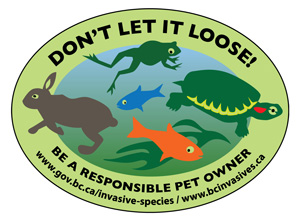Lithobates catesbeianus
Description
- Native to eastern North America
- Can occur in lakes, ponds, wetlands, streams, irrigation ponds and ditches
- A large robust frog reaching up to 20 cm in length and up to 800 g in weight
- Wide flat head and smooth skin with no wrinkles, warts or spikes
- Bullfrogs colour varies from pale green to dark olive and can have brown spots
- Males have bright yellow throats whereas females are pale cream to white throats
- They have large golden eyes
- Mature males have eardrums (circular spot behind eye) twice the diameter of the eye, mature females have eardrums about the same diameter as the eye
- Tadpoles are greenish yellow with small spots, growing up to 15 cm
- Makes a distinct call, it’s bellow is a loud low pitch two – part drone. Want to hear the call? Click the video below.
Consequences of invasion
- Voracious predator that eats anything that fits into its mouth, including endangered native amphibians and fish (including their eggs and larvae)
- Can spread the chytrid fungus, which is responsible for declining amphibian populations
- Readily outcompetes native frog populations. There is scientific evidence that when bullfrog colonies grow in wetlands it is followed by a rapid decline of native frogs
- Tadpoles act as “ecosystem engineers”, meaning they are extremely competitive and take food and habitat away from native frogs
Integrated pest management
- Do NOT purchase bullfrogs as pets
- Never release bullfrogs into the wild
- Do NOT transport wild bullfrogs or tadpoles from place to place, it is illegal under the Wildlife act to capture, transport, keep or sell wild animals including bullfrogs.
- Large tadpoles can be a tempting pet or a popular addition to your backyard pond, but this has been identified as a primary way bullfrogs have been spreading through the province
- “Build it and they will come!” If you want native frogs in your backyard pond the best thing to do is create a welcoming environment for the frogs: water, shelter and insects


